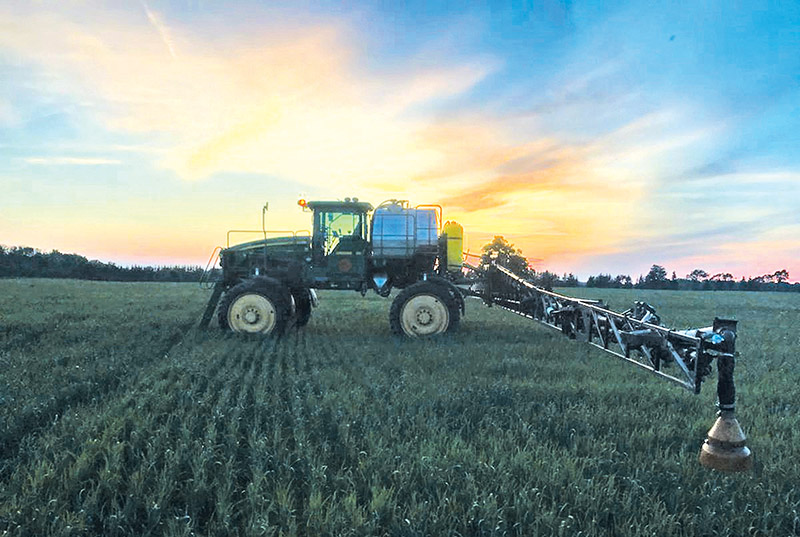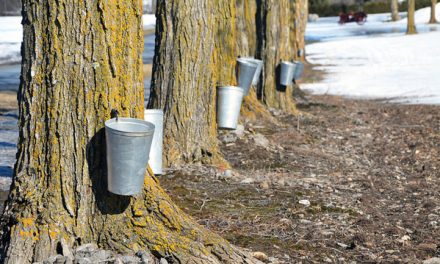Farmer apply organic foliar to reap benefits. Couresy Photo
By Tom Manley
AgriNews Contributor
I have occasionally heard folks express doubt about the integrity of organic production. They recount a situation where they saw an organic farmer spraying in the field, presumably using some kind of herbicide.
They start with the assumption that organic farmers are not supposed to use crop inputs, especially not sprays which are typically associated with pesticides and herbicides.
On the contrary, it is quite common for organic farmers to spray some kind of liquid crop input or a fine solid material in a liquid suspension. In fact, when we advise a conventional farmer about the transition to organic production, we emphatically remind the farmer to keep the sprayer because it will be very useful.
We must first debunk the myth that organic farming is zero-input farming, a kind of “laissez faire” style of hands-off agriculture. Organic agriculture is very much about building natural biological systems that recycle nutrients, leverage natural processes, and prevent pests and diseases. As a consequence, organic farmers apply significantly less inputs than their conventional counterparts. They enjoy superior profits from a combination of higher crop prices and reduced input costs.
But a natural productive eco-system us not achieved by magic. The farmer must invest in time and some inputs to rebalance soil nutrients, rebuild soil biological activity, and re-establish an eco-system that preys on pests and resists diseases. Secondly, organic farmers make selective profitable investments in allowed crop inputs and pest controls to give the natural process a little boost. Many allowed organic crop inputs and pest controls come in liquid form or in fine solids that require liquid suspension for an effective application. Crop spraying in organic production is therefore common in three situations: foliar nutrient applications, disease and fungal control, and pest control.
Compost tea is the process of brewing (fermenting) compost or vermicompost and adding a variety of microbes like beneficial bacteria and fungi. The result is a strong combination of soluble minerals and nutrients with a rich microbial population. Compost tea is applied by broadcast spraying, soil drenching, soil injections, drop irrigation or foliar spraying.
The objective of the compost tea is to help plants form relationships with the microbes to improve plant health, soil microbial populations, root development, and nutrient uptake. Farmers have seen positive results showing up on tissue analyses for nutrient uptake as well as yield checks. As a foliar, compost tea seems to work especially well when paired with liquid fish.
A liquid fish fertilizer is an allowed organic fertilizer made from fresh non-economic fish and fish wastes. A cold crush process protects the vitamins, amino acids, enzymes and growth hormones. It also contains all the micro and macro nutrients naturally found in fish. The nitrogen and other nutrients are chelated, so they are readily available for the plant’s consumption. The liquid fish can be applied as a foliar spray, through a drip irrigational system, or by soil injection.
Suspended clay products such as kaolin clay have been used in organic pest control for thousands of years. Kaolin mixed with spreaders and stickers and applied to plants as a spray at 1–6% concentration in water form. They have proven to be an effective approach to agricultural pest control and to protect plants from environmental stresses.
With support from extensive research, clay sprays deposit a “particle film” and deliver several beneficial effects on plants and in insect pest control. They also form a highly reflective white film over plant surfaces that enhances plant photosynthesis and reduces heat stress in plants by reflecting the infra-red light spectrum. The result is an improvement in plant yields and fruit quality in orchards. The kaolin barrier created by the particle film also protects the treated plant surfaces from diseases and insects.
Dormant oil sprays are made from diluted vegetable oil. They are used on fruit trees before the buds begin to swell in order to suffocate insects and their eggs that are nesting in branches. Without being a complete pest solution, dormant oils cut off most of the population, leaving a simpler problem later in the season. Dormant oils can also be mixed with lime and sulphur to control diseases and scale inspects on fruit trees, roses and ornamentals.
The next time you see a sprayer at work on an organic farm, please drop in to learn more about the farmer’s organic foliar application and its benefits.
References:
https://publications.gc.ca/site/eng/9.894398/publication.html
https://en.wikipedia.org/wiki/Kaolin_spray
https://www.gardeningknowhow.com/edible/fruits/fegen/dormant-oil-information.htm













